Do you know when conception occurs? Do you know the difference between a ‘fetus’ and an ‘embryo’? Every pregnant mother should know the answers to these fundamental questions. After all, this information will guide them throughout the stages of pregnancy.
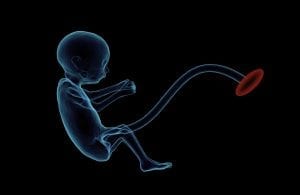
However, not all mothers have a good grasp of this information, especially first-time mothers. Luckily for them, here are the condensed version of everything that they need to know about fetal development.
Definition Of Terms
Before anything else, a pregnant mother must have a clear understanding of what a fetus, an embryo, and a zygote is. Most often, the definition of a fetus is confused with that of the embryo’s or the zygote’s.
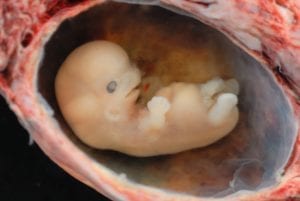
- What is a zygote? (plural form: zygotes) A zygote is a single-cell embryo that is formed during conception. In this stage, the 23 male and female chromosomes are combined.
- What is an embryo? (plural form: embryos) The soon-to-be-child is considered an embryo when it has begun forming essential systems in the body.
- What is a fetus? (plural form: fetuses) The soon-to-be-child is considered a fetus when the ninth week after conception has passed. In this stage, the fetus is focusing on its growth and development.
Conception
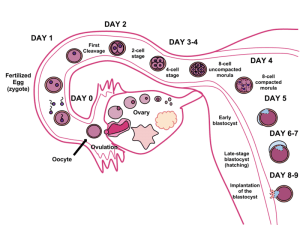
How does conception begin? For starters, it can only start once ovulation occurs. Ovulation begins when the mature follicle releases an egg to be fertilized. When sperm meets the egg, the protein coat of the egg cell will close to prevent other sperms from penetrating. After 24 hours, the egg cell will begin to divide.
As a blastocyte or a fertilized egg, it will continue to divide while traveling from the fallopian tube to the uterus. The blastocyte will attach itself to the lining of the uterus, a process called implantation. After implantation, fetal development can now formally begin.
First Trimester
Fetus development is often divided into trimesters because of the critical and distinct developments to the soon-to-be-child. The first trimester spans for the first week of pregnancy to week 12.
In the first trimester, week 5 is the most crucial period. This time is when the soon-to-be-child is entering its embryonic stage. In week 5 to 7, the embryo’s heart will start to beat. The embryo will also develop basic body features such as arms, legs, and head.
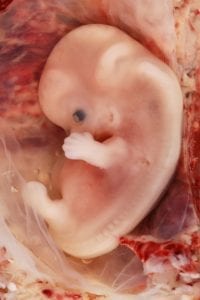
At weeks 8 to 10, the embryo will form eyes, ears, and toes. However, the embryo is still small, spanning for 2 inches. By the end of week 12, the embryo will have grown to 2 ½ inches in length. It will have developed fingernails and refined facial features.
Second Trimester
The 2nd trimester lasts from week 13 to week 26. The embryo is now looking more like a human fetus with its refined features.
At week 15 to 18, the skin of the fetus is still transparent. However, fine hairs called lanugo are growing on its head. Its pancreas and liver start to secrete, while its muscles and bones are becoming stronger. The fetus can move, stretch, and make sucking motions.
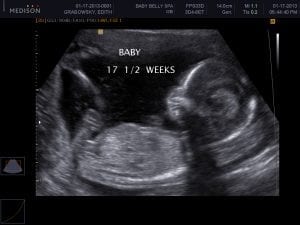
At week 19 to 22, the fetus can hear and swallow. It has now grown active to the point that the mother can feel its motions. Lanugo hairs will cover the entire body of the fetus. Its heartbeat can be heard using a doctor’s stethoscope.
By the end of the twenty-sixth week, the fetus can store fat and produce red blood cells from its bone marrow. The lower airways of the fetus will begin to develop.
Third Trimester
The final trimester spans from week 27 to week 40. In this stage, the fetus will begin preparing for its birth.
In the initiation of the third trimester, the fetus will begin growing rapidly. It can now close and open its eyes thanks to its developing nervous system. At week 31 to 34, the fetus will gain a lot of fat, iron, calcium, and phosphorus. While the fetus’ bones will become fully developed, its respiratory system is still developing.
At week 35 to 27, the fetus will be weighing approximately 2.5 kilograms. Its blood vessels and heart are fully developed. Mothers may notice that their baby has developed definite sleeping patterns. By week 38, the lanugo airs on the baby are gone. Head hair and breast buds are now apparent. The baby is ready to see the world at any moment!
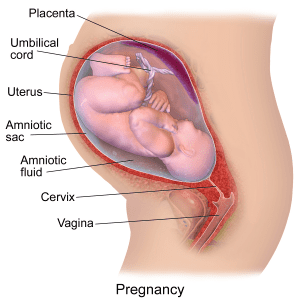
Learning all about these medical concepts at one sitting can be jarring. However, as the weeks go by in your pregnancy, you will eventually come in terms with this topic. But, if you get confused, maybe learning the development in months format or visuals might help.
FAQs About Fetus Development
What are the stages of fetal development?
When understanding fetal development, know that it goes through three stages:
• Germinal stage – It takes place for a couple of weeks after the fetus is conceived.
• Embryonic stage – This is the 3- to 8-week period after conception.
• Fetal stage – The embryo becomes a fetus after two months.
How do I know if my baby is developing normally in the womb?
You know that your baby is developing typically in the womb when you experience abdominal tautness, Braxton-Hicks contractions, and increasing fatigue. It is often accompanied by various levels of pain, too.
How does a two-month fetus look like?
A two-month-old fetus is usually an inch long and looks like a mass with four tiny buds. These buds are the starting points of their legs and arms.
What organ develops first in a fetus?
The heart is the first organ that develops in a fetus. This is why its beating pattern is the main thing that OB-GYNs detect and monitor throughout the pregnancy.
What is the last organ to develop in a fetus?
The lungs are the last organs to develop in a fetus. They are fully functioning before the third trimester ends.
At what point is a fetus a baby?
A fetus becomes a baby once it comes out of the womb. As long as it is in the mom’s belly, it will always be called a fetus.
How can I make my baby healthy in the womb?
• Eat healthy foods.
• Perform the right forms of exercise.
• Avoid drugs, alcohol, cigarettes, and even hot tubs.
What causes a fetus to stop growing?
Understanding fetal development, a fetus stops growing when the placenta is not functioning correctly. This organ is supposed to bring food to the unborn child, so the latter may not develop if the placenta does not work.
What causes abnormalities in the baby during pregnancy?
According to studies, congenital disabilities are caused by infections that moms may contract during pregnancy. They also appear when the expectant mother is exposed to harmful drugs and radiation.
What happens if the baby stops growing at 32 weeks?
When a baby stops growing at 32 weeks, they may deal with health issues, including low birth weight. This condition is known as intrauterine growth restriction (IGR).
Fetus Development Other Resources
Last Updated on January 12, 2023 by Rejie Salazar
DISCLAIMER (IMPORTANT): This information (including all text, images, audio, or other formats on FamilyHype.com) is not intended to be a substitute for informed professional advice, diagnosis, endorsement or treatment. You should not take any action or avoid taking action without consulting a qualified professional. Always seek the advice of your physician or other qualified health provider with any questions about medical conditions. Do not disregard professional medical advice or delay seeking advice or treatment because of something you have read here a FamilyHype.com.